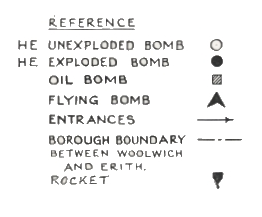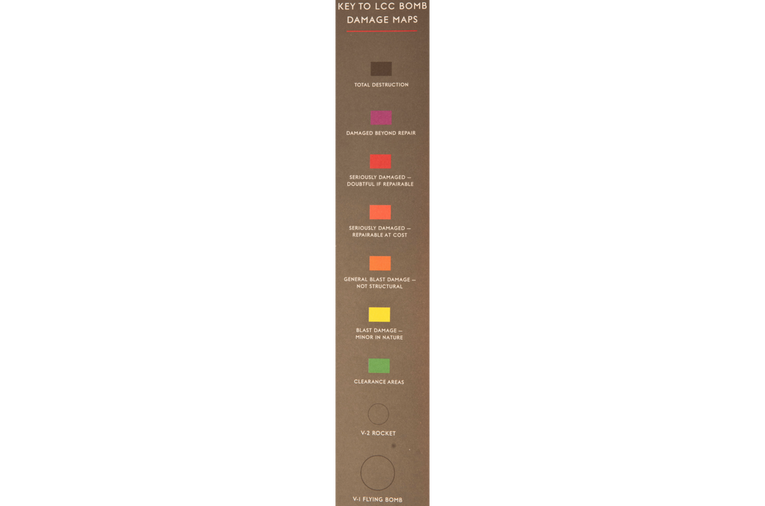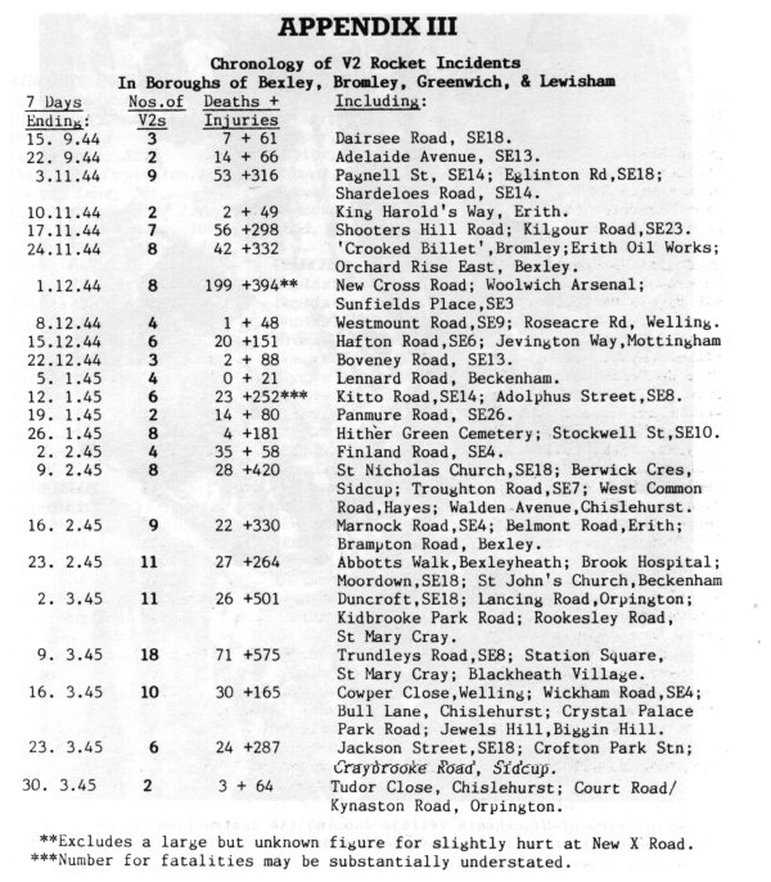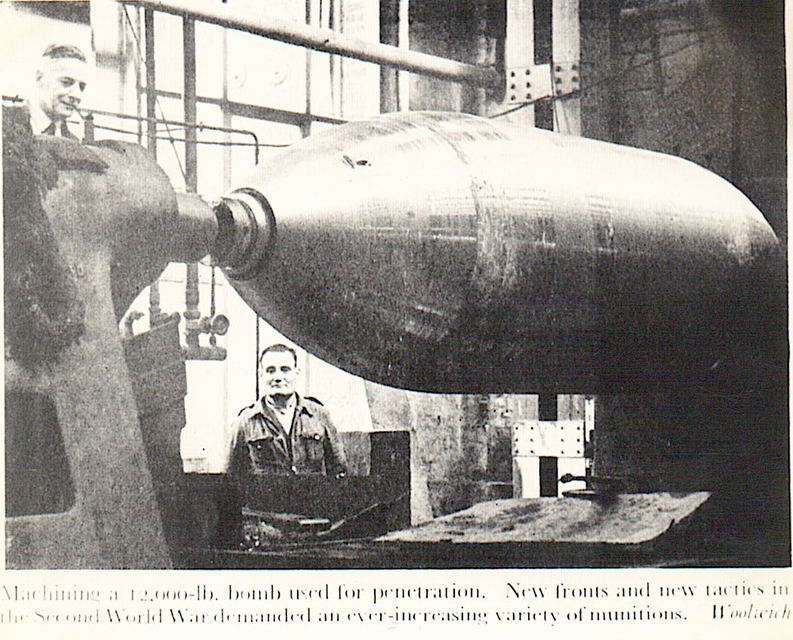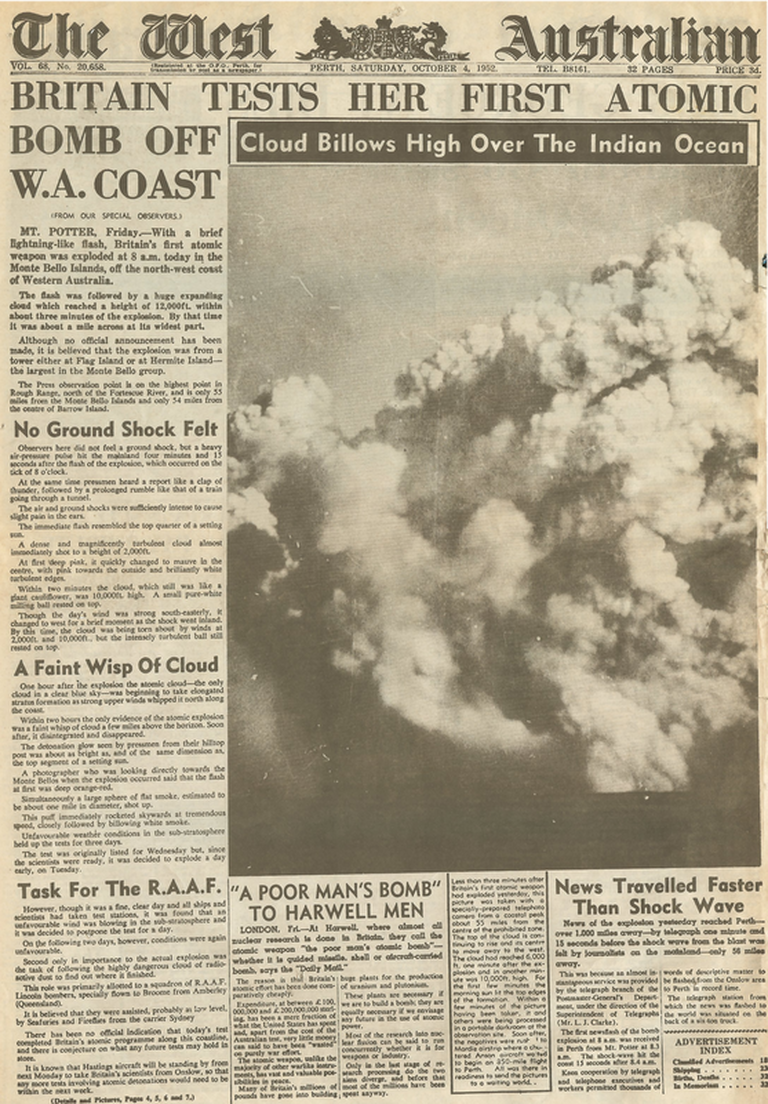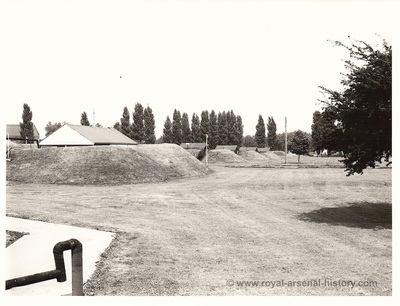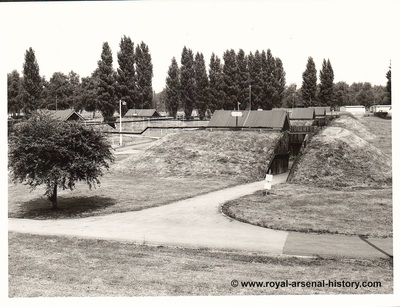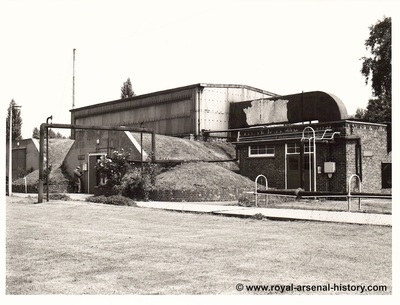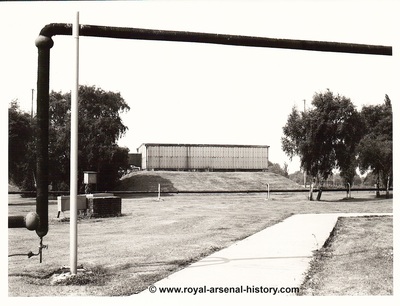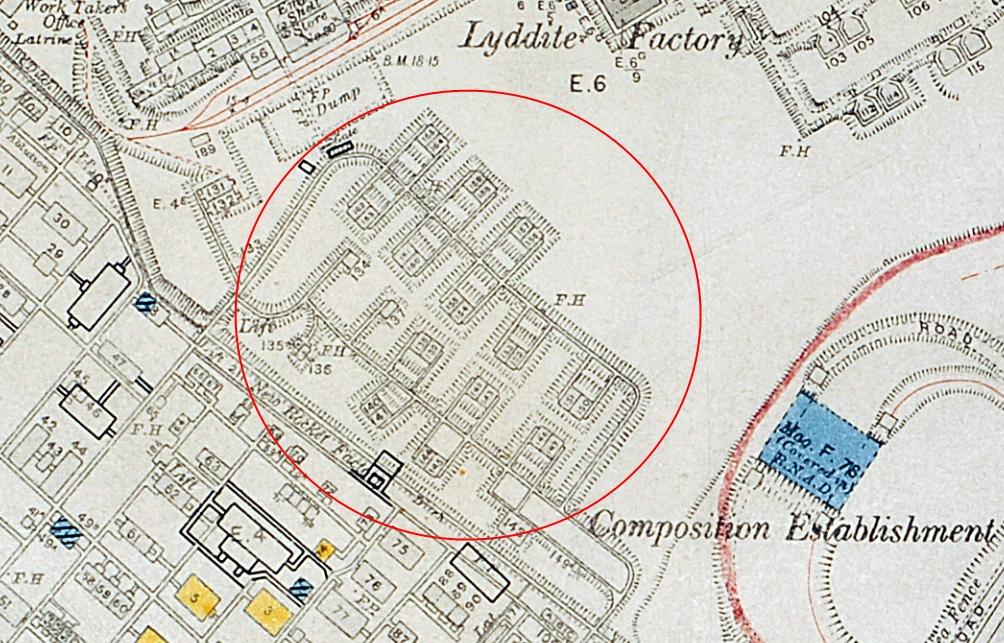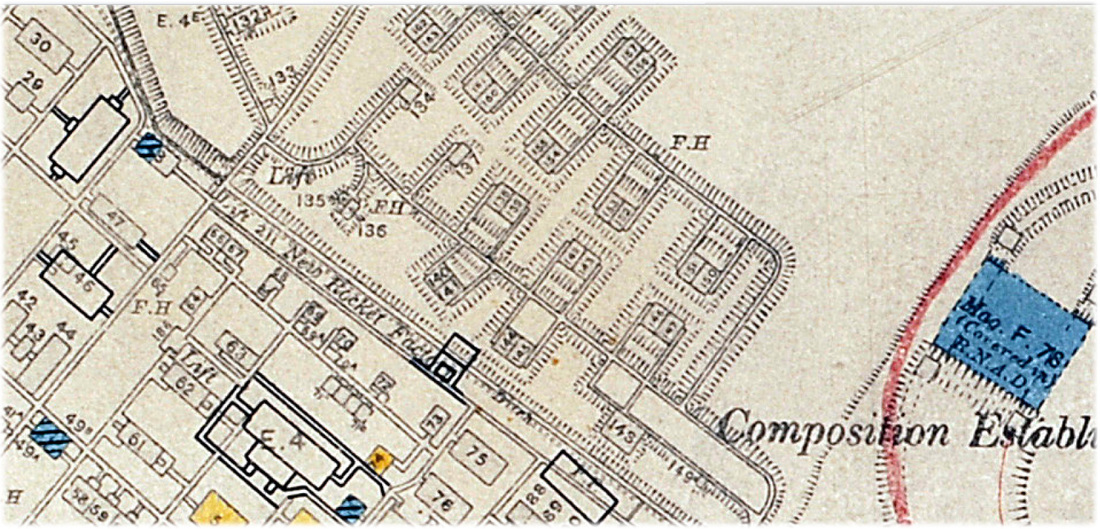Bombs Dropped on Royal Arsenal before 1973
Woolwich 4th June 1939 Woolwich Arsenal Luftwaffe Aerial Image
WW2 German Luftwaffe Target Aerial Reconnaissance Photo
Bombs Dropped on Plumstead
Air Attacks of particular note in Greenwich
18-8-40: First incidents in London County (LCC) area were incendiaries in Woolwich & Eltham, about 4am. Small fires at Halford’s cycle shop, Powis St; Drill Hall, Beie~ord St; Eltham Warren Golf Course; etc.
4—9-40: St Paul’s Church, Fairfield Grove,Charlton virtually destroyed by direct hit, 9.4Opm. Lone bomber. No warning. No one killed.
5/6—9—40: Warning at 9.18pm. Activity lasted till 5am. Woolworth’s, Eltham High St gutted, also Simpson’s, house furnishers;’Castle Hotel’ pub severely damaged by fire; Barker’s Garage in Archery Rd collapsed after fire. HE flattened two houses in Lynsted
Gardens, 3 men killed. 11 injuries. Well Hall Stn set on fire. Westhorne Ave blocked by debris of houses. Plumstead High St blocked by UXB. 18 small fires in Tunnel Ave area.
7/8—9-40: The Great Dockland Raid on Saturday afternoon (4.3Opm—6.15pm) followed by all night raid (8.3Opm—4.48am). About 50 men killed at Woolwich Arsenal. Enormous conflagrations. Arsenal hit by about 100 HEs & thousands of lBs. 87 other fires in Greenwich & Woolwich boroughs, including Woolwich Dockyard, Siemens Bros, Commonwealth Buildings, Delta Metal Co. 12 large fires still out of control at the Arsenal at midnight. HEs blasted the Old Tramyard, Lakedale Rd, Plumstead, Plumstead Stn, Calvert Road School, Greenwich, and numerous streets. At least 32 people killed by HE5,e,g, Lakedale Rd (2), Gallossan Rd (6) ,Norman Rd (3 children in same family), Guild Rd (4, all members of one family), Albert Rd,Eltham (3, mother & two daughters).
Henceforth, all night raids occurred every night until 25 November 1940, except for 2 November]
11—9—40: Severe afternoon raid on SE London. 26 occupants of a basement shelter at Central Hall, Deptford (just inside Greenwich border) killed by direct hit. Fire broke out. About 100 fires in borough, including Plum Lane Girls School (roof destroyed), Commonwealth Buildings & Metal Pressings Ltd, Woolwich Church St (20 pump fire), Siemens Bros (20 pump fire), Hugh Baird & Sons,Greenwich Hi9h St (10 pumps, roof & top floor destroyed). King’s Warren Gj.rle~School haJrf~-demolished by direct hit, 2 firemen killed in AFS station on premises.
17/18—9: Royal Naval College damaged by HE; 3 fires at St Alfege’s Hospital; Maze Hill School, half demolished; HE alongside public shelter in car park of Granada,Woolwich killed 6 people; severe fire (20 pumps) at Furlongs,house furnishers, Powis St badly damaged building & contents; Siemens Bros.,serious fire; 8 died when HE struck entrance to trench shelter at the Vicarage,Eltham High St; about 15 buildings at the Arsenal damaged by blast and fires.
21/22—9: First parachute mines in borough at Camdale Rd (by cemetery wall; Eastview Ave (90 houses destroyed/severely damaged), & a UXmine in Helen St by Woolwich Arsenal Stn, defused by Royal Navy. HE at 92—94 Shooters Hill Rd killed 9 people.
22/23—9: 100 pump timber fire at the Arsenal; nine buildings on fire.
4/5-10: 13 killed & 45 injured by mine at Barnfield Rd, Woolwich. Large fire at Woolwich Dockyard among stores & workshops
10—10-40: Three direct hits by HEs on Anderson shelters in Plumstead (Coupland Terrace, Ann St, & Southport Rd) killed all 12 occupants
18-10-40: Red Lion Lane, Woolwich. Several fatalities. Probably the occasion when ‘The Eagle’ pub was destroyed & Mary Thomas, Woolwich ARP nurse, won the GM for bravery.
7-11-40: Abbey Wood Tram Depot badly damaged by HE. [A fairly quiet night; Greenwich & Woolwich recorded ‘only’ 38 HE bombs!]
10—11-40: HE exploded under public shelter in Armada St. One report referred to 42 deaths & 36 injured, but no supporting evidence found for these high figures. Several children known to have died.
14—11—40: Invicta Road School demolished by mine. 15 killed,including
12 firemen in AFS station on premises. 16 firemen & 7 others injured. Second mine at Charlton Park Lane.
8/9-12—40: Heaviest raid since mid-October. Royal Naval College, Greenwich Observatory, National Maritime Museum all badly damaged. Serious fires at Siemens Bros. 3 killed, 22 injured at Pound Park Road, Charlton where GM won by Albert Brittan of Greenwich Heavy Rescue Service.
29—12-40: Great Fire Raid on City of London. Direct hit by mine on Dyson House, Blackwall Lane claimed 14 lives & injured 100. 30-pump fire at United Glass Works, Anchor & Hope Lane. Other large fires at British Ropes Ltd, G.A.Harvey & Co, etc. Brook Hospit tal damaged by fire.
[By now some 300 civilians had been killed in the borough]
12—1—41: Severe evening raid (6.l8pm—9.45pm) claimed 40 lives in the borough,e.g., Herbert Rd (4), Ripon Rd (4), Nightingale Place (4), Robert St (5), Bastion Rd (5) ,Qriniston Rd (11 killed by direct hit on terraced houses). Two-thirds of all fires in London were in the brrough, including 40 at the Arsenal and Woolwich Dockyard; St Nicholas Church, St Nicholas Hospital, Bostall Lane School (roof & top floor destroyed) ,Burrage Grove School, Bloomfield Road School, Joe Lyons in Powis St were among 83 other fires. Woolwich Polytechnic was severely damaged by HEs.
28—1—41: Direct hit on factory shelter of Varley Magnet Works,Bloomfield Rd in an afternoon raid killed 4 young factory girls and injured 38.
30-1-41: A lunchtime raid on central Woolwich. 8 HE bombs in Powis St.
12 people killed at the Arsenal by two HE5.
15—3—41: Sharp evening attack on SE London. First Aid Post & Welfare Centre in Westhorne Ave struck by HE. At least 9 killed & 15 injured, mostly nurses & medical attendants.
19/20—3—41: First of four heavy raids in spring of 1941. 168 HE5 and mines in the borough and about 120 fires. Among the worst incidents: RAF Kidbrooke (major fire), RN College (severe fire), British Ropes Ltd (major fire), Eastmoor St (9 killed by mine), St Alfege’s Parish Church (gutted), Ursuline Convent School, Crooms Hill (roof burned off), Charlton Greyhound Stadium (hit by HE), Arsenal (31 HE5 + numerous IBs),etc. At least 76 killed.
16/17-4—41: Main assault on outer districts of SE London, but Avery Hill Teachers’ training College severely damaged by fire, also ~RAF Kidbrooke again (30 pumps needed). St Nicholas Hospital damaged by HEs.
19/20—4—41: Third big spring raid, lasted from 9.2Opm till 4.46am. A wet Saturday night. 14 mines in the borough but miraculously no loss of life caused by.them! Large fires at the Arsenal, the Woolwich Institution, Siemens Bros.,Commonwealth Buildings, Holy Trinity Church (Woolwich Rd), RN College, the Seamen’s Hospital, Brook Hospital, Nationa~ Maritime Museum (Queens House), Plumstead High St School, etc. Direct hit on Mulgrave Place School killed 3 firemen. At least 50 people killed in HE incidents, including 6 in Owenite St., Abbey Wood, 6 in
Eastney St.,Greenwich, 10 in Charlton, and 4 in Vincent Rd.
10/11-5—41: Final raid of the Blitz. Lasted from 11pm till 5am. Main concentration on central districts, but Greenwich badly hit. 12 killed in and around Trafalgar Rd. Greenwich public baths blown apart. East Greenwich police station badly damaged.
Plumstead Central School severely damaged by fire (roof off, etc), and several fires in Pluinstead High St shops,’Red Lions pub, Plumstead Cinema, etc.
1943: About 50 raids all told. Usually quite small and short,but made very noisy by enlarged AA defences. Genuine battles between the guns and the raiders.
17/18 January: Two raids this night brought 70 HEs -fit-numerous lBs down on the borough. (6 deaths in Whinyates & Appleton Roads, Eltham).
20 January: Severe low—level daylight raid on SE London. 107 people died, over half children.
21 October: Arsenal hit. 3 killed in Ankerdine & Brinklow Crescents.
6 November: 5 RAF men reported killed on balloon site in Voce Road.
Jan—Mar 1944: The so called Baby Blitz. Severe incendiary raids. Among local incidents were 3 firewatchers killed at the RACS store, Blithdale Rd (18 Feb); 4 killed by one-ton para bomb in Leysdown Rd., Elthem
(29 Jan); St Barnabas Church,Rochester Way gutted, 7 killed in area by lBs & HEs, 10 fires at Siemens Bros, 8 fires at RACS stores,Woolwich Rd.,severe fire at RAF Kidbrooke, ‘Butterfly’ bombs in Greenwich
(2 Mar); 20 industrial fires in Tunnel Ave area; 496 fires in SE London out of 722 in London in total
(22 Mar). Last raid by manned planes on London was 19 April.
V1 Campaign: Main bombardment was from 15/6/44 till 31/8/44, followed by occasional arrivals till 28/3/45. During main campaign the borough was hit by 155 V1s, plus a few afterwards. Among the worst were Plumstead High St (16 killed, 85 injured) ,Woolwich Arsenal (16 killed, 112 injured), Greenwich Church St (13 + 40), Devonshire Drive (12 + 38), & Burney St (12 + 13).
V2 Campaign: Bombardment lasted from 8/9/1944 till 27/3/1945. The borough was hit by 53 V2 rockets, including air bursts. The first was at Dairsee Road on 14 Sept (7 kill.ed, 83 injured). Among the worst were Shooters Hill Rd (26 + 25), Sunfields Place (19 + 50), Troughton Rd (14 + 46), Moordown (12 + 40), Duncroft (13 + 81) & Jackson St (15 + 100).
Compiled by Lewis Blake,10/1989
4—9-40: St Paul’s Church, Fairfield Grove,Charlton virtually destroyed by direct hit, 9.4Opm. Lone bomber. No warning. No one killed.
5/6—9—40: Warning at 9.18pm. Activity lasted till 5am. Woolworth’s, Eltham High St gutted, also Simpson’s, house furnishers;’Castle Hotel’ pub severely damaged by fire; Barker’s Garage in Archery Rd collapsed after fire. HE flattened two houses in Lynsted
Gardens, 3 men killed. 11 injuries. Well Hall Stn set on fire. Westhorne Ave blocked by debris of houses. Plumstead High St blocked by UXB. 18 small fires in Tunnel Ave area.
7/8—9-40: The Great Dockland Raid on Saturday afternoon (4.3Opm—6.15pm) followed by all night raid (8.3Opm—4.48am). About 50 men killed at Woolwich Arsenal. Enormous conflagrations. Arsenal hit by about 100 HEs & thousands of lBs. 87 other fires in Greenwich & Woolwich boroughs, including Woolwich Dockyard, Siemens Bros, Commonwealth Buildings, Delta Metal Co. 12 large fires still out of control at the Arsenal at midnight. HEs blasted the Old Tramyard, Lakedale Rd, Plumstead, Plumstead Stn, Calvert Road School, Greenwich, and numerous streets. At least 32 people killed by HE5,e,g, Lakedale Rd (2), Gallossan Rd (6) ,Norman Rd (3 children in same family), Guild Rd (4, all members of one family), Albert Rd,Eltham (3, mother & two daughters).
Henceforth, all night raids occurred every night until 25 November 1940, except for 2 November]
11—9—40: Severe afternoon raid on SE London. 26 occupants of a basement shelter at Central Hall, Deptford (just inside Greenwich border) killed by direct hit. Fire broke out. About 100 fires in borough, including Plum Lane Girls School (roof destroyed), Commonwealth Buildings & Metal Pressings Ltd, Woolwich Church St (20 pump fire), Siemens Bros (20 pump fire), Hugh Baird & Sons,Greenwich Hi9h St (10 pumps, roof & top floor destroyed). King’s Warren Gj.rle~School haJrf~-demolished by direct hit, 2 firemen killed in AFS station on premises.
17/18—9: Royal Naval College damaged by HE; 3 fires at St Alfege’s Hospital; Maze Hill School, half demolished; HE alongside public shelter in car park of Granada,Woolwich killed 6 people; severe fire (20 pumps) at Furlongs,house furnishers, Powis St badly damaged building & contents; Siemens Bros.,serious fire; 8 died when HE struck entrance to trench shelter at the Vicarage,Eltham High St; about 15 buildings at the Arsenal damaged by blast and fires.
21/22—9: First parachute mines in borough at Camdale Rd (by cemetery wall; Eastview Ave (90 houses destroyed/severely damaged), & a UXmine in Helen St by Woolwich Arsenal Stn, defused by Royal Navy. HE at 92—94 Shooters Hill Rd killed 9 people.
22/23—9: 100 pump timber fire at the Arsenal; nine buildings on fire.
4/5-10: 13 killed & 45 injured by mine at Barnfield Rd, Woolwich. Large fire at Woolwich Dockyard among stores & workshops
10—10-40: Three direct hits by HEs on Anderson shelters in Plumstead (Coupland Terrace, Ann St, & Southport Rd) killed all 12 occupants
18-10-40: Red Lion Lane, Woolwich. Several fatalities. Probably the occasion when ‘The Eagle’ pub was destroyed & Mary Thomas, Woolwich ARP nurse, won the GM for bravery.
7-11-40: Abbey Wood Tram Depot badly damaged by HE. [A fairly quiet night; Greenwich & Woolwich recorded ‘only’ 38 HE bombs!]
10—11-40: HE exploded under public shelter in Armada St. One report referred to 42 deaths & 36 injured, but no supporting evidence found for these high figures. Several children known to have died.
14—11—40: Invicta Road School demolished by mine. 15 killed,including
12 firemen in AFS station on premises. 16 firemen & 7 others injured. Second mine at Charlton Park Lane.
8/9-12—40: Heaviest raid since mid-October. Royal Naval College, Greenwich Observatory, National Maritime Museum all badly damaged. Serious fires at Siemens Bros. 3 killed, 22 injured at Pound Park Road, Charlton where GM won by Albert Brittan of Greenwich Heavy Rescue Service.
29—12-40: Great Fire Raid on City of London. Direct hit by mine on Dyson House, Blackwall Lane claimed 14 lives & injured 100. 30-pump fire at United Glass Works, Anchor & Hope Lane. Other large fires at British Ropes Ltd, G.A.Harvey & Co, etc. Brook Hospit tal damaged by fire.
[By now some 300 civilians had been killed in the borough]
12—1—41: Severe evening raid (6.l8pm—9.45pm) claimed 40 lives in the borough,e.g., Herbert Rd (4), Ripon Rd (4), Nightingale Place (4), Robert St (5), Bastion Rd (5) ,Qriniston Rd (11 killed by direct hit on terraced houses). Two-thirds of all fires in London were in the brrough, including 40 at the Arsenal and Woolwich Dockyard; St Nicholas Church, St Nicholas Hospital, Bostall Lane School (roof & top floor destroyed) ,Burrage Grove School, Bloomfield Road School, Joe Lyons in Powis St were among 83 other fires. Woolwich Polytechnic was severely damaged by HEs.
28—1—41: Direct hit on factory shelter of Varley Magnet Works,Bloomfield Rd in an afternoon raid killed 4 young factory girls and injured 38.
30-1-41: A lunchtime raid on central Woolwich. 8 HE bombs in Powis St.
12 people killed at the Arsenal by two HE5.
15—3—41: Sharp evening attack on SE London. First Aid Post & Welfare Centre in Westhorne Ave struck by HE. At least 9 killed & 15 injured, mostly nurses & medical attendants.
19/20—3—41: First of four heavy raids in spring of 1941. 168 HE5 and mines in the borough and about 120 fires. Among the worst incidents: RAF Kidbrooke (major fire), RN College (severe fire), British Ropes Ltd (major fire), Eastmoor St (9 killed by mine), St Alfege’s Parish Church (gutted), Ursuline Convent School, Crooms Hill (roof burned off), Charlton Greyhound Stadium (hit by HE), Arsenal (31 HE5 + numerous IBs),etc. At least 76 killed.
16/17-4—41: Main assault on outer districts of SE London, but Avery Hill Teachers’ training College severely damaged by fire, also ~RAF Kidbrooke again (30 pumps needed). St Nicholas Hospital damaged by HEs.
19/20—4—41: Third big spring raid, lasted from 9.2Opm till 4.46am. A wet Saturday night. 14 mines in the borough but miraculously no loss of life caused by.them! Large fires at the Arsenal, the Woolwich Institution, Siemens Bros.,Commonwealth Buildings, Holy Trinity Church (Woolwich Rd), RN College, the Seamen’s Hospital, Brook Hospital, Nationa~ Maritime Museum (Queens House), Plumstead High St School, etc. Direct hit on Mulgrave Place School killed 3 firemen. At least 50 people killed in HE incidents, including 6 in Owenite St., Abbey Wood, 6 in
Eastney St.,Greenwich, 10 in Charlton, and 4 in Vincent Rd.
10/11-5—41: Final raid of the Blitz. Lasted from 11pm till 5am. Main concentration on central districts, but Greenwich badly hit. 12 killed in and around Trafalgar Rd. Greenwich public baths blown apart. East Greenwich police station badly damaged.
Plumstead Central School severely damaged by fire (roof off, etc), and several fires in Pluinstead High St shops,’Red Lions pub, Plumstead Cinema, etc.
1943: About 50 raids all told. Usually quite small and short,but made very noisy by enlarged AA defences. Genuine battles between the guns and the raiders.
17/18 January: Two raids this night brought 70 HEs -fit-numerous lBs down on the borough. (6 deaths in Whinyates & Appleton Roads, Eltham).
20 January: Severe low—level daylight raid on SE London. 107 people died, over half children.
21 October: Arsenal hit. 3 killed in Ankerdine & Brinklow Crescents.
6 November: 5 RAF men reported killed on balloon site in Voce Road.
Jan—Mar 1944: The so called Baby Blitz. Severe incendiary raids. Among local incidents were 3 firewatchers killed at the RACS store, Blithdale Rd (18 Feb); 4 killed by one-ton para bomb in Leysdown Rd., Elthem
(29 Jan); St Barnabas Church,Rochester Way gutted, 7 killed in area by lBs & HEs, 10 fires at Siemens Bros, 8 fires at RACS stores,Woolwich Rd.,severe fire at RAF Kidbrooke, ‘Butterfly’ bombs in Greenwich
(2 Mar); 20 industrial fires in Tunnel Ave area; 496 fires in SE London out of 722 in London in total
(22 Mar). Last raid by manned planes on London was 19 April.
V1 Campaign: Main bombardment was from 15/6/44 till 31/8/44, followed by occasional arrivals till 28/3/45. During main campaign the borough was hit by 155 V1s, plus a few afterwards. Among the worst were Plumstead High St (16 killed, 85 injured) ,Woolwich Arsenal (16 killed, 112 injured), Greenwich Church St (13 + 40), Devonshire Drive (12 + 38), & Burney St (12 + 13).
V2 Campaign: Bombardment lasted from 8/9/1944 till 27/3/1945. The borough was hit by 53 V2 rockets, including air bursts. The first was at Dairsee Road on 14 Sept (7 kill.ed, 83 injured). Among the worst were Shooters Hill Rd (26 + 25), Sunfields Place (19 + 50), Troughton Rd (14 + 46), Moordown (12 + 40), Duncroft (13 + 81) & Jackson St (15 + 100).
Compiled by Lewis Blake,10/1989
V2 Rockets
Arsenal Info From Red Alert - South East London 1939-45 by Lewis Blake
Sat 7th Sept 1940
Fire pumps converged on the Royal Arsenal like antibodies massing to combat an infection of the human system. The streets outside were jammed with hundreds of pumps and vehicles of all shapes and sizes. Hosepipes wound and zig zagged on the pavements and in the gutters. To the layman it looked like organised chaos ó perhaps it was. Inside the site a gigantic conflagration raged out of control. The AFS and the fullótime professionals of the London Fire Brigade (LFB) battled gallantly against a spreading inferno,among falling bombs, exploding crates of nitroglycerine, stacks of live ammunition, and demented shells from burning dumps hurtling everywhere. Buildings fiercely ablaze included several storehouses, a fuze factory, a filling works, a gun factory, acid stores, offices, railway sidings, a police post, and much else. Over 10 per cent of all fatalities in the raid occurred at the Royal Arsenal ó 50 men killed all told.
Sun 15th Sept 1940
One victim of the afternoonís battles was a Heinkel which fell burning in a sort of 1azy, slowómotion spiral near shellófilling huts at the Royal Arsenal, where it exploded and started a fire. Four crew members perished in the crash.
Bomb Damage Spetember 1940
Woolwich Arsenal was hit by 194 HE bombs, 12 oil bombs, and countless IBs during September. Serious fires and blast damage
occurred on eight nights, e.g., 100ópump fires on the 9th and 22nd badly damaged 130 buildings on the site.
12th Jan 1941
A sharp raid on the 12th, between 6.2Opm and 9.45pm, badly affected the Woolwich area; in fact, twoóthirds of all London fire incidents related to Woolwich, Plumstead, and Abbey Wood. At the Arsenal and the Dockyard alone there were forty fires, including two large outbreaks requiring 30 pumps at each.
Thurs 30th Jan 1941
Sudden death came to central Woolwich again at lunchtime on Thursday, 30 January. The Arsenal suffered its worst casualties since the great Dockland raid with twelve lives lost.The offending missiles were part of a series which also swept the length of Powis Street, damaging Marks & Spencer and a restaurant. The Kentish Independent commented (without specifying the location, of course) that many people had narrow escapes in the restaurant. One waitress was carrying a tray down a flight of stairs when she heard the bombs coming: ìI dropped the tray and went flatî, she said ruefully. Reporting narrow escapes made better ëcopyí than talking about loss of life ó and it was better for morale. In truth, a lot more people narrowly escaped death or injury when a bomb dropped than were victims.
H.E. Bomb Incidents 19th March 1941
Woolwich Arsenal: Hit by 31 HEs. Direct hits on 12 buildings.
21st Oct 1943
A 5501b HE sank four 3Oft launches after a fire near TóPier on the Woolwich Arsenal site.
21st Jan 1944 `The Baby Blitz`
Woolwich Arsenal also contended about thirty fires, none serious.
General Info 1944
MILITARY AND INDUSTRIAL TARGETS
Generally speaking, the popular image of the V1 offensive is that while it devastated thousands of homes, shops, schools, and churches in the capital it barely touched targets of military or economic value. In truth, it is hardly to be expected that some proportion of 2,400 missiles would not find out factories, docks, railway stations, and the like. Many of the affected works and buildings are today put to entirely new uses; others are but forgotten names of Londonís industrial past. All the more reason,
perhaps, for recording some of the warís grim moments in those places.
The Royal Arsenal, Woolwich was Londonís No.1 militaryóindustrial establishment, without question. If one were guided by maps in the local Press showing the locations of V1 incidents which were published soon after the campaign ended, it would seem that the Arsenal avoided all involvement. But this was simply warótime censorship. At around midóday on 1 July,a direct
hit on two brick airóraid shelters claimed 16 lives and injured 112. It destroyed paint, boiler repair, and pipe fitters workshops, and a womenís rest room. One former engineer in the light gun factory recalls that he had a deep aversion to the brick shelters, regarding them as anything but safe. He preferred, instead, to shelter under heavy machinery in the factory, a habit which on this occasion probably saved his life.
This was the first and the worst of the Arsenalís V1 incidents. But at 5pm on 27 July a hit among filling sheds led to another five deaths and 64 injuries. Hot fragments of the missile smouldered undetected in a cartridge store until on the following day the building suddenly burst into flames.A pair of buzz bombs struck the site more or less together at 1pm on 2 August, demolishing laboratories, canteens, and the pay office. This time there were four fatalities and 71 injuries. A hit near one of the gates on
24 August killed two people and injured 31. And right at the end of the summer assault, on 31 August, there were 19 injuries and severe damage over a wide area. The Royal Arsenal was never a safe place to be during the war, as the tally of 324 casualties in the V1 campaign alone amply illustrates.
In the early morning of 5 August, one particular V1 exploded on a moored barge, just missing the Woolwich Free Ferry. The barge disappeared in a cloud of debris,while two others moored alongside simply sank in the mud.
3rd Aug 1944
Hits on the Thames foreshore at the Woolwich Arsenal.
Sat 7th Sept 1940
Fire pumps converged on the Royal Arsenal like antibodies massing to combat an infection of the human system. The streets outside were jammed with hundreds of pumps and vehicles of all shapes and sizes. Hosepipes wound and zig zagged on the pavements and in the gutters. To the layman it looked like organised chaos ó perhaps it was. Inside the site a gigantic conflagration raged out of control. The AFS and the fullótime professionals of the London Fire Brigade (LFB) battled gallantly against a spreading inferno,among falling bombs, exploding crates of nitroglycerine, stacks of live ammunition, and demented shells from burning dumps hurtling everywhere. Buildings fiercely ablaze included several storehouses, a fuze factory, a filling works, a gun factory, acid stores, offices, railway sidings, a police post, and much else. Over 10 per cent of all fatalities in the raid occurred at the Royal Arsenal ó 50 men killed all told.
Sun 15th Sept 1940
One victim of the afternoonís battles was a Heinkel which fell burning in a sort of 1azy, slowómotion spiral near shellófilling huts at the Royal Arsenal, where it exploded and started a fire. Four crew members perished in the crash.
Bomb Damage Spetember 1940
Woolwich Arsenal was hit by 194 HE bombs, 12 oil bombs, and countless IBs during September. Serious fires and blast damage
occurred on eight nights, e.g., 100ópump fires on the 9th and 22nd badly damaged 130 buildings on the site.
12th Jan 1941
A sharp raid on the 12th, between 6.2Opm and 9.45pm, badly affected the Woolwich area; in fact, twoóthirds of all London fire incidents related to Woolwich, Plumstead, and Abbey Wood. At the Arsenal and the Dockyard alone there were forty fires, including two large outbreaks requiring 30 pumps at each.
Thurs 30th Jan 1941
Sudden death came to central Woolwich again at lunchtime on Thursday, 30 January. The Arsenal suffered its worst casualties since the great Dockland raid with twelve lives lost.The offending missiles were part of a series which also swept the length of Powis Street, damaging Marks & Spencer and a restaurant. The Kentish Independent commented (without specifying the location, of course) that many people had narrow escapes in the restaurant. One waitress was carrying a tray down a flight of stairs when she heard the bombs coming: ìI dropped the tray and went flatî, she said ruefully. Reporting narrow escapes made better ëcopyí than talking about loss of life ó and it was better for morale. In truth, a lot more people narrowly escaped death or injury when a bomb dropped than were victims.
H.E. Bomb Incidents 19th March 1941
Woolwich Arsenal: Hit by 31 HEs. Direct hits on 12 buildings.
21st Oct 1943
A 5501b HE sank four 3Oft launches after a fire near TóPier on the Woolwich Arsenal site.
21st Jan 1944 `The Baby Blitz`
Woolwich Arsenal also contended about thirty fires, none serious.
General Info 1944
MILITARY AND INDUSTRIAL TARGETS
Generally speaking, the popular image of the V1 offensive is that while it devastated thousands of homes, shops, schools, and churches in the capital it barely touched targets of military or economic value. In truth, it is hardly to be expected that some proportion of 2,400 missiles would not find out factories, docks, railway stations, and the like. Many of the affected works and buildings are today put to entirely new uses; others are but forgotten names of Londonís industrial past. All the more reason,
perhaps, for recording some of the warís grim moments in those places.
The Royal Arsenal, Woolwich was Londonís No.1 militaryóindustrial establishment, without question. If one were guided by maps in the local Press showing the locations of V1 incidents which were published soon after the campaign ended, it would seem that the Arsenal avoided all involvement. But this was simply warótime censorship. At around midóday on 1 July,a direct
hit on two brick airóraid shelters claimed 16 lives and injured 112. It destroyed paint, boiler repair, and pipe fitters workshops, and a womenís rest room. One former engineer in the light gun factory recalls that he had a deep aversion to the brick shelters, regarding them as anything but safe. He preferred, instead, to shelter under heavy machinery in the factory, a habit which on this occasion probably saved his life.
This was the first and the worst of the Arsenalís V1 incidents. But at 5pm on 27 July a hit among filling sheds led to another five deaths and 64 injuries. Hot fragments of the missile smouldered undetected in a cartridge store until on the following day the building suddenly burst into flames.A pair of buzz bombs struck the site more or less together at 1pm on 2 August, demolishing laboratories, canteens, and the pay office. This time there were four fatalities and 71 injuries. A hit near one of the gates on
24 August killed two people and injured 31. And right at the end of the summer assault, on 31 August, there were 19 injuries and severe damage over a wide area. The Royal Arsenal was never a safe place to be during the war, as the tally of 324 casualties in the V1 campaign alone amply illustrates.
In the early morning of 5 August, one particular V1 exploded on a moored barge, just missing the Woolwich Free Ferry. The barge disappeared in a cloud of debris,while two others moored alongside simply sank in the mud.
3rd Aug 1944
Hits on the Thames foreshore at the Woolwich Arsenal.
Royal Arsenal Output figures
|
1914-1918
Guns made Guns repaired Gun carriages made Gun carriages repaired Shells made Shells filled Gun cartridges filled Fuzes made Fuzes filled Small arms bullets made |
Arsenal output
4,326 5,434 2,165 1,217 5,847,400 19,910,300 46,121,200 3,368,200 59,251,400 1,718,813,228 |
Bombs made in the Arsenal
Bullets made in the Arsenal
The German Bombers
The Dornier Do 17, sometimes referred to as the Fliegender Bleistift or 'flying pencil', was a WW2 bomber intended to be light enough to outrun defending fighter aircraft.
As seen in the background photo on this website rendered in colour from black and white photo.
The Dornier 17 was deisgned in the early 1930s with two engines and twin tail fin configuration to make the plane more manoeuvrable at low altitude while it's thin frame made it less vulnerable to attack. The Dornier was used by the Luftwaffe throughout the war, and saw action in significant numbers in every major campaign theatre as a front line aircraft until the end of 1941.
Few Dornier Do 17s survived the war. The last was scrapped in Finland in 1952.
Salvaging a rare WWII plane from the seabed - Please see here for more information.
German WWII Dornier to be raised from Goodwin Sands - Please see here for more information
Restoration of German WWII Dornier - Please see here for more information
Few Dornier Do 17s survived the war. The last was scrapped in Finland in 1952.
Salvaging a rare WWII plane from the seabed - Please see here for more information.
German WWII Dornier to be raised from Goodwin Sands - Please see here for more information
Restoration of German WWII Dornier - Please see here for more information
Productions weapons
Blue Danube, Red Beard, Yellow Sun and W177
*Researching 2016*
*Researching 2016*
Atomic age
Were parts of the Arsenal involved in the project for Britain's first Atomic bomb...?
Answer: Yes
The report, outlining the features of an atomic bomb based on the U.S. Fat Man pattern, and the tasks required to develop one for Britain, was declassified and made available to the the public under the Public Records Act (now amended by the Freedom of Information Act which came into force in January 2005).
The report, outlining the features of an atomic bomb based on the U.S. Fat Man pattern, and the tasks required to develop one for Britain, was declassified and made available to the the public under the Public Records Act (now amended by the Freedom of Information Act which came into force in January 2005).
Project Hurricane
In 1947 Sir William Penny was instructed by labour Prime Minister (Clement Atlee) to design and build a British nuclear weapon. This was in response to the USA denying access to the Atomic weapon developed jointly by the USA & UK (Manhatten project). The Americans thought the UK was too insecure with this information probably rightly so as there were significant communist leaning members of the establishment.
The project was called Hurricane, initial work started in the Arsenal then spread to the atomic Weapons Research estabilishment on Woolwich common then to Aldermaston. The weapon was successfully tested at the Montebelow Islands near Australian in 1952.
The project was called Hurricane, initial work started in the Arsenal then spread to the atomic Weapons Research estabilishment on Woolwich common then to Aldermaston. The weapon was successfully tested at the Montebelow Islands near Australian in 1952.
Located in a secure guarded compound at the heart of the site, Air Vice-Marshal Davis, in charge of security, issued orders that none but Ministers of the Crown were to be allowed inside. Other Ordnance Factory staff were to be told, simply, "We're doing a job which is a bit tricky, so in the interests of safety these buildings are out-of-bounds".
John Challens, who designed the firing circuits for the 32 detonators to initiate the explosive sphere around "Hurricane"'s plutonium core, died in March 2002. Testing at Shoeburyness was completed at the last minute before the Monte Bello nuclear test. Challens' genius achieved the required simultaneous detonation accurate to millionths of a second.
John Challens, who designed the firing circuits for the 32 detonators to initiate the explosive sphere around "Hurricane"'s plutonium core, died in March 2002. Testing at Shoeburyness was completed at the last minute before the Monte Bello nuclear test. Challens' genius achieved the required simultaneous detonation accurate to millionths of a second.
A part of the Royal Arsenal East where they made the Atomic Bomb lasted until 2004 and was demolished in 2009 for an extension to Belmarsh prison. Security was seriously tight right up until the end. A friend went to have a look after closure and as he stood at the fence in Hadden Road he was watched by three security guards who wouldn't say a word. There were signs saying "photography and sketching is forbidden"
Sir William Penney's plan, entitled Plutonium Weapon - General Description is available on this link. It is complete with Penney's written report, and his diagrams of the planned weapon
In June 1947 Sir William Penney began assembling a team to work on the bomb. One of his first steps was to prepare a document describing the features of the U.S. implosion bomb, breaking down the development tasks required to replicate it, and identifying outstanding questions that required further research. This report was completed on 1 July, was entitled Plutonium Weapon - General Description (UK Public Record Office File AVIA 65/1163, "Implosion") and gave the British atomic weapons program a preliminary design description.
The project was also code named Basic High Explosive Research or BHER (later just HER) and was based at Woolwich Arsenal. Unlike the U.S. atomic bomb project which had been centrally located at the custom built facility of Los Alamos, BHER drew on existing groups scattered over several sites. In addition to Woolwich, Armament Research Department (ARD) at Fort Halstead and other sites were involved. Furthermore not all aspects of bomb development resided with BHER. Although BHER was responsible for the overall weapon design, and the development and fabrication of the implosion system, the manufacture of the plutonium core initially resided with the plutonium production program under Hinton.
See here for more details
In June 1947 Sir William Penney began assembling a team to work on the bomb. One of his first steps was to prepare a document describing the features of the U.S. implosion bomb, breaking down the development tasks required to replicate it, and identifying outstanding questions that required further research. This report was completed on 1 July, was entitled Plutonium Weapon - General Description (UK Public Record Office File AVIA 65/1163, "Implosion") and gave the British atomic weapons program a preliminary design description.
The project was also code named Basic High Explosive Research or BHER (later just HER) and was based at Woolwich Arsenal. Unlike the U.S. atomic bomb project which had been centrally located at the custom built facility of Los Alamos, BHER drew on existing groups scattered over several sites. In addition to Woolwich, Armament Research Department (ARD) at Fort Halstead and other sites were involved. Furthermore not all aspects of bomb development resided with BHER. Although BHER was responsible for the overall weapon design, and the development and fabrication of the implosion system, the manufacture of the plutonium core initially resided with the plutonium production program under Hinton.
See here for more details
Your browser does not support viewing this document. Click here to download the document.
Danger Building Area E
I also believe some of the buildings used in the Royal Arsenal East for the Atomic bomb program where possibly related to "Danger Building area E" below. The reason being is the area closed down in 1919, it was used again in 1947/50 (The Project hurricane dates). I have no evidence of this, but this area is still there today. Why untouched over 60 years later? The proposed river crossing perhaps. Please leave comments below to discuss further.
Below: Danger building area today, Last remaining building area of the East wasteland. Also see text Rocket Factory just below.
Below: Danger Building Area E today
More information on this danger building area here.
Rockets
The rocket, for land or sea service use, was often as dangerous to fire as to manufacture. The gunpowder had to be tightly compressed in the tube for the weapon to be effective; the Arsenal's rocket factory was therefore sited in isolation on the eastern side of the canal. Congreve's first large rockets at Woolwich, from 1805, achieved a range of 2,000 yards, and soon the Arsenal was making 32lbr rockets with a 3,000 yard range. Had they been accurate, they would have been deadly.
Hyder Ali and his son, Tipu Sultan, gave Colonel Wellesley an unpleasant surprise during the siege of Seringapatam in 1799; they fired rockets at him. The Indian rockets (one of which survives in Firepower's collection) were sophisticated, and in advance of anything Britain had at that time. It is believed that Colonel Congreve worked from a captured example at the Arsenal in developing the Congreve Rocket. It was, essentially, a black powder charge in a round soft-iron case on the end of a long stick.
Hyder Ali and his son, Tipu Sultan, gave Colonel Wellesley an unpleasant surprise during the siege of Seringapatam in 1799; they fired rockets at him. The Indian rockets (one of which survives in Firepower's collection) were sophisticated, and in advance of anything Britain had at that time. It is believed that Colonel Congreve worked from a captured example at the Arsenal in developing the Congreve Rocket. It was, essentially, a black powder charge in a round soft-iron case on the end of a long stick.
Torpedoes
The torpedoes were made at Woolwich until 1910 (by the Royal Gun Factory after 1890), when manufacture moved to Greenock. The first above-water launching was made when the Navy slid a 14" torpedo off a mess-table and through a porthole. The later cradle used by HMS Thunderer on the left does not seem a great improvement. Powered by compressed air driving contra-rotating propellers, the early Woolwich torpedoes had a range of up to 800 yards.
The first ship to be sunk by a torpedo was the Blanco Encalada in 1891 during the Chilean revolutionary war. Hit by a single torpedo, she sank immediately. The captain, Don Luis Goni, was ejected up a ventilation shaft and into the sea by the explosion, and was last seen swimming ashore with his arm around the ship's mascot, a Llama. The creature was taken onboard HMS Warspite as a mascot, until, having eaten the epaulettes off an Admiral's dress uniform, it was banished to London Zoo in disgrace.
The first ship to be sunk by a torpedo was the Blanco Encalada in 1891 during the Chilean revolutionary war. Hit by a single torpedo, she sank immediately. The captain, Don Luis Goni, was ejected up a ventilation shaft and into the sea by the explosion, and was last seen swimming ashore with his arm around the ship's mascot, a Llama. The creature was taken onboard HMS Warspite as a mascot, until, having eaten the epaulettes off an Admiral's dress uniform, it was banished to London Zoo in disgrace.
Britain tests her first Nuclear bomb!
The scientists were not the only ones to witness the nuclear tests around Australia. In order to test military clothing and equipment, sailors and marines were exposed to the flash. Many of them were national servicemen in their teens or early twenties. One recalls
We knew it was going to be an explosion. We were never told it was an atom bomb though it had come through the grapevine. They started the countdown and there was this flash and I could see right through my hands, the bones in them, it was like an x-ray of my hands, even though my eyes were shut. Then there was more like a roar, a rumble than a bang. And then we turned round and opened our eyes and just after there was this hot wind and you could feel it like grit hitting your body. The ship rocked slightly. And that was it.
The Nuclear Test Veterans claim abnormally high rates of cancers and ill-health as a result of their exposure, and an independent study by the University of Dundee Medical School supports this. However, this is disputed by the Government, which relies on a study carried out by the National Radiological Protection Board that suggests such illnesses are not attributable to exposure to nuclear testing.
We knew it was going to be an explosion. We were never told it was an atom bomb though it had come through the grapevine. They started the countdown and there was this flash and I could see right through my hands, the bones in them, it was like an x-ray of my hands, even though my eyes were shut. Then there was more like a roar, a rumble than a bang. And then we turned round and opened our eyes and just after there was this hot wind and you could feel it like grit hitting your body. The ship rocked slightly. And that was it.
The Nuclear Test Veterans claim abnormally high rates of cancers and ill-health as a result of their exposure, and an independent study by the University of Dundee Medical School supports this. However, this is disputed by the Government, which relies on a study carried out by the National Radiological Protection Board that suggests such illnesses are not attributable to exposure to nuclear testing.
